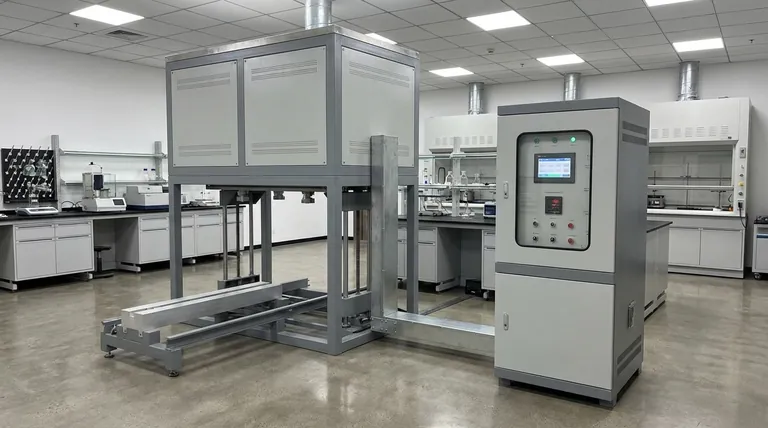In essence, a muffle furnace is a high-temperature laboratory oven that excels at one critical task: heating a substance without it ever coming into direct contact with the heat source. This is achieved by placing the sample inside an insulated, enclosed chamber (the "muffle"), which is then heated from the outside. This design ensures both temperature uniformity and protection from contamination.
The defining feature of a muffle furnace is not just its ability to reach high temperatures, but its method of isolating the material being processed. This separation is crucial for applications where chemical purity and precise thermal conditions are non-negotiable.

How a Muffle Furnace Achieves High-Temperature Isolation
A muffle furnace, also known as a chamber or retort furnace, is designed around the principle of indirect heating. Understanding its core components reveals why it is an indispensable tool in science and industry.
The "Muffle" Concept
The term "muffle" refers to the central chamber that contains the material to be heated. This chamber is constructed from high-temperature-resistant materials.
The walls of this chamber act as a barrier, separating the workload from the heating elements and the external environment.
Modern Electric Heating
Modern muffle furnaces are overwhelmingly electric. High-temperature resistive heating coils are embedded within the thick, insulated walls surrounding the muffle chamber.
When electricity passes through these coils, they generate intense heat. This heat radiates or convects through the chamber walls to uniformly raise the temperature of the sample inside, without any direct contact.
The Critical Benefit of Isolation
Historically, furnaces were fueled by coal or wood. The muffle was essential to protect the sample from soot, ash, and gases produced during combustion.
In today's electric furnaces, this isolation remains vital. It prevents any potential reaction between the sample and the heating elements themselves, ensuring the sample's chemical integrity is maintained.
Key Applications in Research and Quality Control
The unique design of a muffle furnace makes it the standard equipment for several precise thermal processes.
Ashing and Gravimetric Analysis
One of the most common uses is ashing, which involves burning a sample at a high temperature to remove all organic matter.
This process leaves behind only the inorganic, noncombustible components (the ash). By weighing the sample before and after, researchers can accurately determine its inorganic content, a critical step in many quality control procedures.
Material Heat Treatment
Muffle furnaces provide the controlled, high-temperature environment needed for treating materials like metals and ceramics.
Processes such as hardening, annealing, and tempering require precise temperature curves to achieve the desired material properties, free from surface contamination.
Chemical Decomposition and Analysis
Scientists use muffle furnaces to decompose chemical compounds or to drive volatile components out of a sample.
The furnace's ability to maintain a stable, uniform temperature ensures that these reactions proceed predictably and completely, which is essential for accurate analysis.
Understanding the Key Characteristics
While powerful, a muffle furnace is a specialized tool with specific strengths. Recognizing these is key to using it effectively.
Precision Over Scale
Muffle furnaces offer exceptional temperature control and uniformity, which is paramount for laboratory work. They are designed for batch processing of smaller samples, not for large-scale industrial production.
Contamination Control
The absolute separation of the sample from the heating source is the furnace's primary advantage. This guarantees that the only variable being introduced is heat, not external chemical contaminants.
Energy Efficiency
The same thick insulation that allows the furnace to reach and maintain extreme temperatures also prevents heat from escaping. This makes modern muffle furnaces relatively self-contained and energy-efficient.
When to Use a Muffle Furnace
The decision to use a muffle furnace hinges on the need for thermal purity and precision.
- If your primary focus is determining the inorganic content of a sample (ashing): The muffle furnace is the standard tool for completely and cleanly burning off all organic matter for accurate measurement.
- If your primary focus is heat-treating materials without surface contamination: Its isolated chamber ensures the sample is only exposed to a uniform temperature, not reactive gases or direct contact with heating elements.
- If your primary focus is high-temperature chemical analysis: The furnace provides the stable, precisely controlled, and pure environment required for repeatable and reliable results.
Ultimately, a muffle furnace is the essential tool for any high-temperature process where the integrity of the sample cannot be compromised.
Summary Table:
| Key Feature | Benefit |
|---|---|
| Indirect Heating | Isolates samples from heat source, preventing contamination. |
| High-Temperature Chamber | Enables precise thermal processes like ashing and heat treatment. |
| Temperature Uniformity | Ensures consistent, reliable results for analysis and testing. |
| Contamination Control | Maintains sample integrity for accurate gravimetric analysis. |
Ready to achieve pure, high-temperature processing in your lab?
KINTEK specializes in providing reliable laboratory equipment, including high-performance muffle furnaces designed for precision ashing, heat treatment, and chemical analysis. Our solutions ensure contamination-free results and temperature uniformity critical for your research and quality control.
Contact us today to find the perfect muffle furnace for your specific application and enhance your lab's capabilities.
Visual Guide

Related Products
- Laboratory Muffle Oven Furnace Bottom Lifting Muffle Furnace
- 1700℃ Muffle Oven Furnace for Laboratory
- 1400℃ Muffle Oven Furnace for Laboratory
- 1800℃ Muffle Oven Furnace for Laboratory
- 1400℃ Laboratory Quartz Tube Furnace with Alumina Tube Tubular Furnace
People Also Ask
- Why do we need to use properly some of the laboratory apparatus in the laboratory? The Foundation of Safe and Accurate Science
- What is the difference between a crucible and a furnace? Understanding the Heat Source and Container Partnership
- At what temperature is it safe to open a muffle furnace? A Guide to Preventing Injury and Equipment Damage
- What are the factors affecting the rate of melting process? Master Heat Transfer for Faster Results
- What is the burnout cycle on a furnace? Stop This Destructive Overheating Pattern Now



















